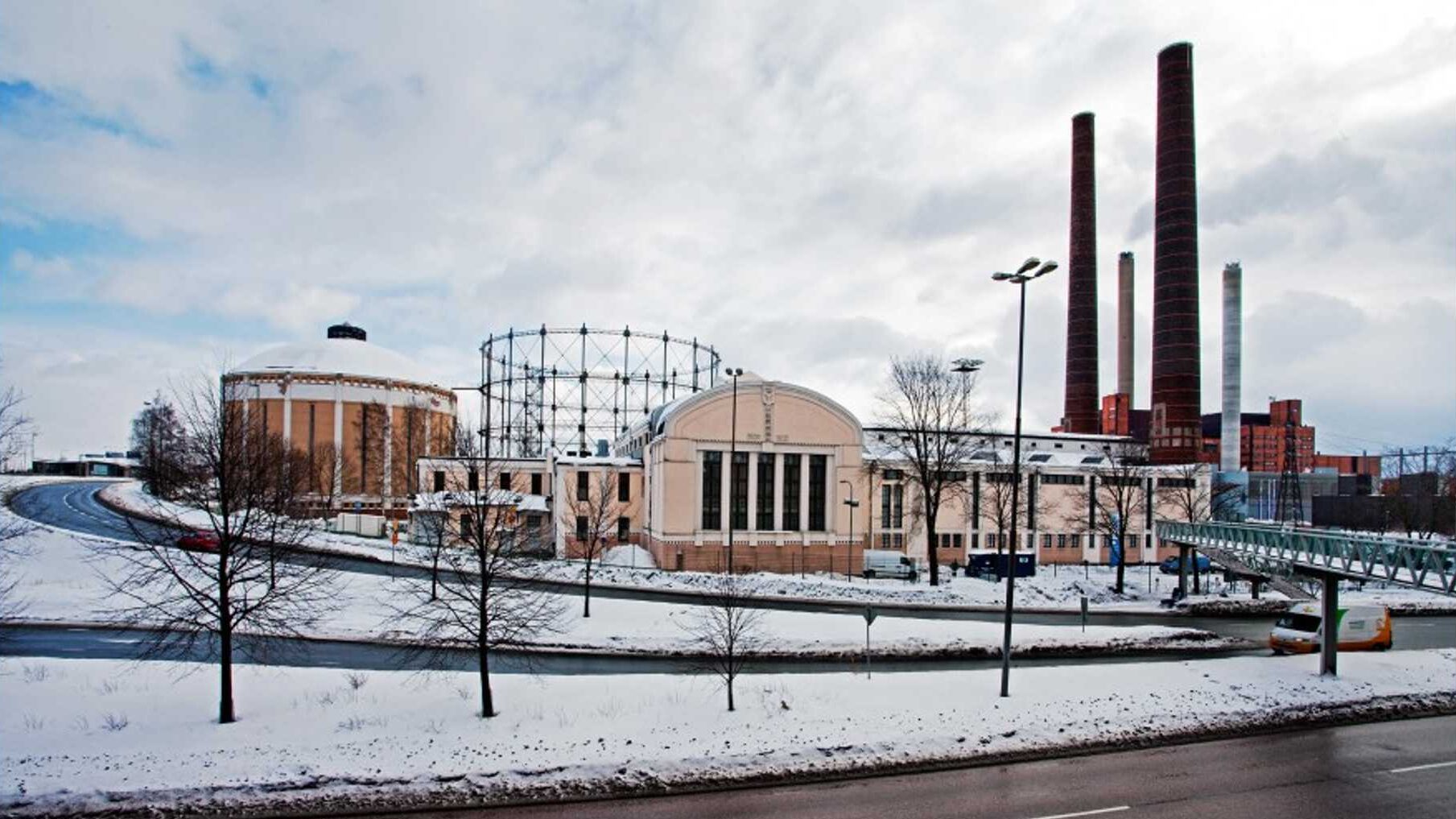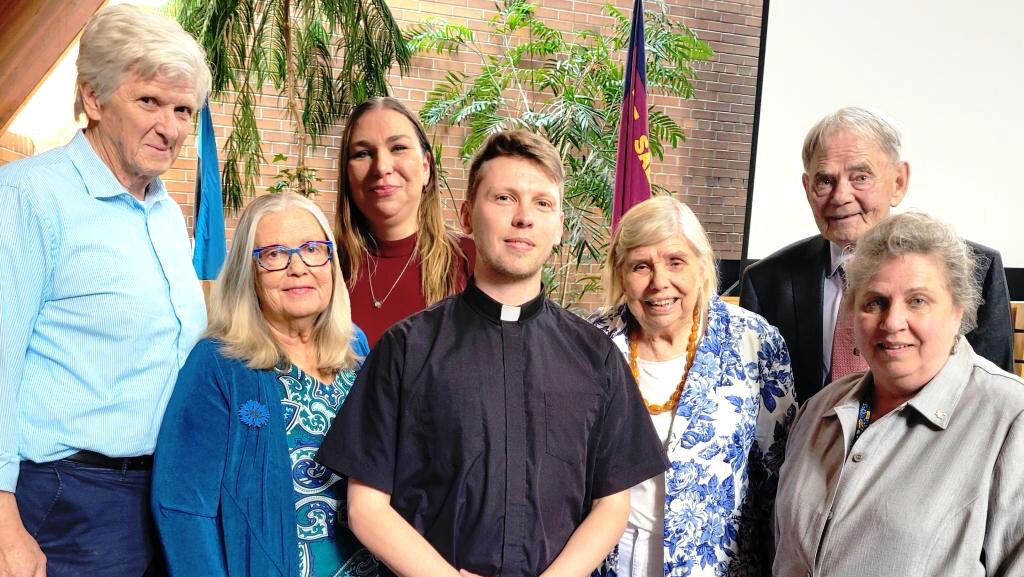When it was opened on September 17th of that year, the Mayor of Tallinn, Helsinki's Deputy Mayor, and both Estonia and Finland's Ministers of Culture gave speeches. The Tallinn Boy's Choir serenaded the audience, while DJ Otso Kantokorpi, Singer Vinger, and Finnish rock star Kauko Röyhkä got the party going in the evening. Spirits were high with a place for the neighbourly relations between Estonia and Finland to continue growing.
The building would appear to be an unlikely place for an Estonian cultural centre. From the road, you can see two tall brick chimneys and two other chimneys further in the background. This is because the Eesti Maja is side-by-side with Kattilahalli, a power plant boiler hall from 1909. The area of Helsinki where the Estonian House is situated, Suvilahti, is an industrial area with historic connections to energy generation. Upgrades to the area have been ongoing, and since the 80s, it's become a more hip part of town that's home to theatre, film, and music events like Flow Festival, which has drawn major touring musicians. The formerly industrial spaces are useful for holding events. Kattilahalli has a maximum capacity of 990 people and a hall with 1,150 square metres of space.
The Eesti Maja itself, located at Sörnäisten rantatie 22, has 624 square metres of space, and is bursting with action. Before 2010, Estonians gathered at Mariankatu 8, in the city centre of Helsinki. The newer location is further away, but still adheres to its aim of establishing new or maintaining existing connections to Estonia for people of all ages.
A big driver for these activities is Tuglas-seura (Tuglas Society), an Estonian-Finnish cross-cultural organization, named after Estonian writer Friedebert Tuglas. Tuglas-seura was founded in 1982 and has branches across Finland. At the Helsinki Eesti Maja, promotion of the Estonian language and culture is bolstered by the Baltic Library they operate, with 33,000 Estonian items, including a large collection of fiction and history books. The library also has newspapers, magazines, over 2,000 Estonian films in the video library, around 1,000 music recordings, and thousands of photographs. It's a resource for research, with a reading room and loaning available for many books, videos, and audio from after 1900.
The Eesti Maja has academic connections. The Baltic Library collection is linked to the University of Helsinki Library system. An office of the University of Tartu was opened on the premises to “further intensify our teaching and research contacts with Finnish partners…” as Alar Karis, former Rector of the university stated. This adds to the already high number of international students from Finland at the University of Tartu.
Business is promoted here. Ettevõtluse Arendamise Sihtasutuse (Enterprise Estonia) has an office in the building, dealing with trade and the growth of investment and business opportunities. Consulting services are offered and contacts for business partnerships are put together.
Starting in October 2020, the building has held a showroom for Oot-Oot, an Estonian furniture business that creates sofas and other seating. Marko Ala and Joonas Torim, the founders of Oot-Oot, design durable, minimalist Nordic furniture and sell it from their website.
Language courses in Estonian, led by teachers Maiu Juurik and Helja Kirber, and Finnish, taught by Ramona Lepik, take place at the Eesti Maja. There are many options for Estonian language courses: level 1, 2, 3, two advanced courses, a writing course, Estonian through literature, and online courses with conversational practice. Usually, Estonian language themed days with lunch take place on Saturday, from 12:00 to 3:30 PM. There are exams, too, to measure and certify proficiency in Estonian.
On the online front, the Helsinki Eesti Maja has its own YouTube channel with cooking shows, discussions, and more.
And this is just part of what's available to Estonians in Finland. Finland has the largest number of Estonians outside of Estonia in the world; a sizable community of around 70,000 people, many of whom are in Helsinki. Just like in Canada, all possible strategies, new and old, have been used to try to maintain a connection to Estonia.
There are cultural groups like those for singing in Estonian. There are specialty supermarkets with Estonian food brands: for instance, Eestin Extrat in the Lassila neighbourhood of west Helsinki or the Eestin Herkut store in the Vuosaari neighbourhood, at the water's edge in east Helsinki.
In November, there is the Martin markkinat (Saint Martin's Day Fair). Thousands of visitors come by, to see what's offered by Estonian food and craft vendors. Each year, the fair highlights a different region of Estonia.
2020 marked the 10 year anniversary of the new location of Helsinki's Eesti Maja. As each year goes by, visitors from Monday to Friday show how Estonians are still emigrating to Finland. The reasons vary. But even in a country with many cultural similarities, there's a universal desire to connect back to a distinct home identity.
This article was written by Vincent Teetsov as part of the Local Journalism Initiative.




